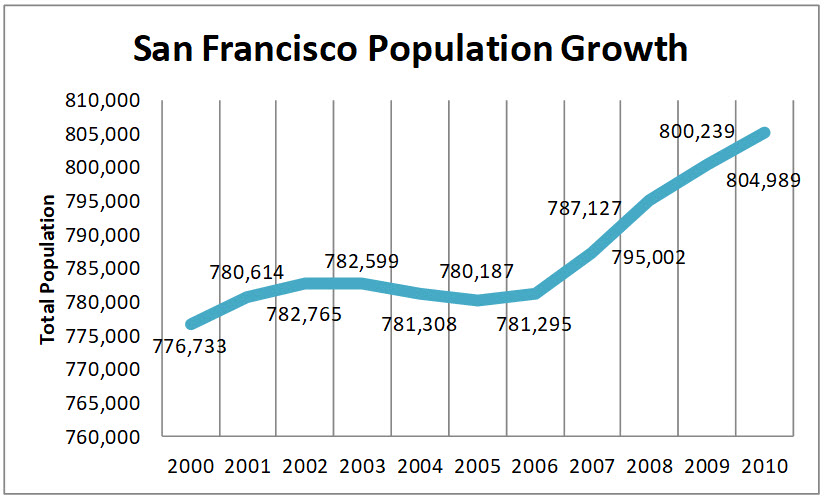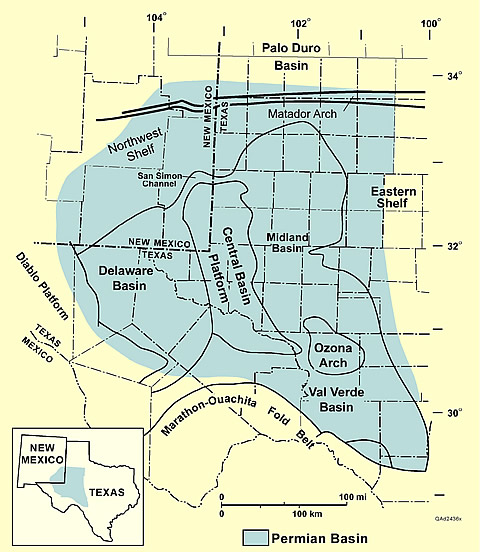Recently, we’ve been seeing news articles about micro-apartments. We have found these 200- to 300-square-foot apartments incredibly interesting, and ultimately we decided to analyze why they are coming on the scene, as well as what types of markets might find these units ideal. The need for micro-apartments comes primarily from the increasing number of individuals moving to cities. This increased demand for small apartments can cause a shortage in the supply of single-occupant housing.
Many of the cities experiencing shortages in single-occupant apartments seem to be high-tech hubs (at least in the United States); these housing shortages likely correlate to job growth in these locales.[1] The graph used in this posting shows how following the recession, the population growth in San Francisco (one of the cities experimenting with these micro-apartment units) began to rise dramatically. However, we proffer that tech workers in urban areas may not be the best target market for these units, because tech workers typically have a higher median income that affords them more dwelling options. For example, if you look at the tech workforce in Silicon Valley, you’ll find that tech job earnings are experiencing 5.2% income growth and outpacing the 2% national average tech worker income growth.[2]

Source: Greenfield Advisors, LLC and the California Department of Finance.
It is typically the increased demand for housing with no change in supply and a lack of land that makes these single-occupant micro-apartments an interesting development option, but there are factors to consider other than just the types of job growth in an area. For instance, promoters of these micro-apartments should also consider zoning, nearby amenities, climate, and demographic/market characteristics.
Zoning
Zoning in certain areas (such as San Francisco) might allow for micro-apartments; however, they may not be allowed in all urban areas due to zoning laws. Some of the articles we have been looking at noted that zoning/planning officials were making exceptions to test how these units would work. New York City has already changed the laws on apartment size so that developers can build these units. Some planners were concerned that in more expensive housing markets, lower-income families would try to occupy these units. However, to help mitigate this concern, restrictions in the zoning laws can limit the occupancy provided such limited space.
Nearby Amenities
With typically just under 300 square feet of living space, potential occupants will likely consider the areas nearby and what recreational and entertainment features are available. For instance, with such a small space, in-home entertaining of guests might not be ideal. A market area with “lots to do” would make these units more attractive. Access to transportation services would also make these units more attractive because it would allow “micro-dwellers” to have even more options for entertainment outside of the home.
Climate
The climate of an area might be something else to consider, albeit heating a micro-apartment in the winter or cooling it in the summer would be quite economical. In areas with harsh winters (or summers), such a limited amount of living space and reduced desire for outside activities might make these units less attractive.
Demographic/Market Characteristics
Micro-apartments might do well in urban college towns like Boston where there have been housing shortage problems. They might also do well in cities where there is not necessarily a housing shortage, but where it is difficult to find low-rent apartments in prime locations. These very small apartments might also be attractive to individuals moving into the United States from other countries or domestically from long distances. This is because many of these apartments come pre-furnished (or require very little furniture), thus reducing moving costs. Additionally, these micro-apartments provide individuals with cheaper rents that allow them to save money as they are starting out in a new location.
The ideal demographic for “micro-dwellers” is likely to be young adults and single individuals, though micro-apartment design could have its place in senior housing in urban areas as well. If you would like to check out this phenomenon of 200- to 300-square-foot apartments designed to help with the recent overabundance in city-dwellers, here are some links you might enjoy:
Galante, Meredith. 2012. “Why Micro Apartments Are The Next Big Trend In City Living.” Business Insider, November 6, 2012. Accessed January 23, 2013 at http://www.businessinsider.com/micro-apartment-trend-2012-10.
Riley, Neal J. 2012. “S.F. Supervisors Back Micro-Apartments.” San Francisco Chronicle, November 20, 2012. Accessed January 23, 2013 at http://www.sfgate.com/bayarea/article/S-F-supervisors-back-micro-apartments-4055493.php#photo-3192504.
Hurst, Nathan. 2012. “Take That, Tokyo! San Francisco Approves 220-Square-Foot ‘Micro-Apartments.’”Wired, November 20, 2012. Accessed January 23, 2013 at http://www.wired.com/design/2012/11/san-francisco-micro-apartments/.
Wolan, Malia. 2012. “San Franciscans Divide Over Pint-Size Apartments.” The New York Times, September 26, 2012. Accessed January 23, 2013 at http://www.nytimes.com/2012/09/27/us/micro-unit-apartment-proposal-divides-san-francisco.html?_r=0.
By: Abigail Mooney and Sarah J. Kilpatrick






Recent Comments